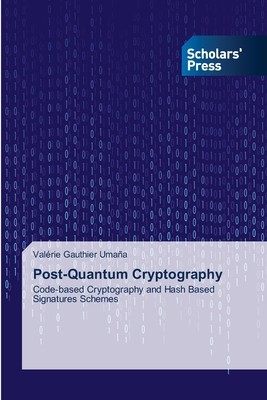
- We will send in 10–14 business days.
- Author: Valérie Gauthier Umaña
- Publisher: Scholars' Press
- Year: 2014
- Pages: 200
- ISBN-10: 3639715500
- ISBN-13: 9783639715507
- Format: 15.2 x 22.9 x 1.2 cm, softcover
- Language: English
- SAVE -10% with code: EXTRA
Reviews
Description
Quantum computers will break the security of almost all the public-key cryptosystems used in practice. This book focus on two classes of cryptography that can resist these emerging attacks. In the first part, we introduce coding theory and give an overview of code-based cryptography. The main contribution is an attack on two promising cryptosystem (joint work with Gregor Leander). We also present a deterministic polynomial-time algorithm to solve the Goppa Code Distinguisher problem for high rate codes (joint work with Jean-Charles Faugère, Ayoub Otmani, Ludovic Perret and Jean-Pierre Tillich). In the second part, we give an overview of hash based signature schemes that are a good quantum resistant alternative to the used signature schemes. We propose a new variant of the classical one-time signature schemes based on (near-)collisions resulting in two-time signature schemes and give a new, simple and efficient algorithm for traversing a tree in tree-based signature schemes (joint work with Lars Knudsen and Søren Thomsen).
EXTRA 10 % discount with code: EXTRA
The promotion ends in 17d.13:07:32
The discount code is valid when purchasing from 10 €. Discounts do not stack.
- Author: Valérie Gauthier Umaña
- Publisher: Scholars' Press
- Year: 2014
- Pages: 200
- ISBN-10: 3639715500
- ISBN-13: 9783639715507
- Format: 15.2 x 22.9 x 1.2 cm, softcover
- Language: English English
Quantum computers will break the security of almost all the public-key cryptosystems used in practice. This book focus on two classes of cryptography that can resist these emerging attacks. In the first part, we introduce coding theory and give an overview of code-based cryptography. The main contribution is an attack on two promising cryptosystem (joint work with Gregor Leander). We also present a deterministic polynomial-time algorithm to solve the Goppa Code Distinguisher problem for high rate codes (joint work with Jean-Charles Faugère, Ayoub Otmani, Ludovic Perret and Jean-Pierre Tillich). In the second part, we give an overview of hash based signature schemes that are a good quantum resistant alternative to the used signature schemes. We propose a new variant of the classical one-time signature schemes based on (near-)collisions resulting in two-time signature schemes and give a new, simple and efficient algorithm for traversing a tree in tree-based signature schemes (joint work with Lars Knudsen and Søren Thomsen).


Reviews